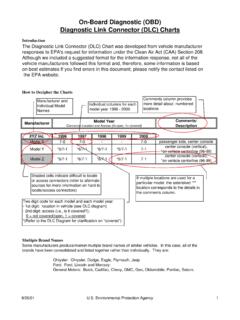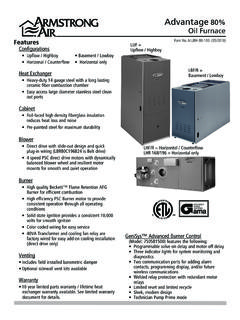Transcription of RepairWatch PUBLIC REPORT
1 RepairWatch PUBLIC REPORT . A quarterly repair effectiveness REPORT from Georgia's Clean Air Force (GCAF). repair facility listings for the metro Atlanta area Expires July 31, 2018. What is the RepairWatch PUBLIC REPORT ? The RepairWatch PUBLIC REPORT is compiled by the Georgia Environmental Protection Division (EPD) and Georgia's Clean Air Force (GCAF). This REPORT is produced quarterly and covers the reporting period of October 1, 2017 - March 31, 2018. RepairWatch is a repair effectiveness program developed to meet requirements of the Federal Clean Air Act and to assist vehicle owners with identifying effective emissions repair facilities. The RepairWatch PUBLIC REPORT can be used by vehicle owners as a guide for locating emissions repair facilities meeting the established criteria. All state-certified emissions inspection stations are required to have the RepairWatch PUBLIC REPORT available for PUBLIC review. Each inspection station and repair facility will receive one copy of the REPORT .
2 Additional copies may be printed from our website at The RepairWatch PUBLIC REPORT includes repair facilities meeting all of the following criteria during the reporting period: Completed 12 or more emissions-related repairs within the designated six month reporting period;. I nitial retest passage rates were 80 percent or better; and Vehicles received all recommended emissions-related repairs. Stations will not be included in this REPORT if their license is suspended or revoked at the time of printing. The REPORT is developed by collecting and analyzing emissions-related repairs and retest results. repair and retest information in the REPORT is compiled according to the repair facility phone number entered on the Emissions repair Form and indicates which repair facility was associated with specific vehicle repairs. The information on the Emissions repair Form is entered into a database by the emissions inspector at the time of the first after-repairs retest.
3 Remember: It remains your right and responsibility as a consumer to evaluate and choose a repair facility. GCAF recommends calling your repair facility for more information prior to taking your vehicle there. This REPORT is not intended as a recommendation or endorsement by the Georgia Environmental Protection Division (EPD) or their Management Contractor of the facilities included herein. This REPORT is intended only as an information source to help vehicle owners locate repair facilities conducting emissions-related repairs. Inclusion in this REPORT does not signify that these repair facilities possess particular repair skills or that they are the only such facilities qualified to make emissions related repairs. Rather, the facilities included in the REPORT are those facilities that have made emissions related repairs within the six month reporting period on at least 12 vehicles that failed their initial emissions inspection, and those vehicles had all recommended emissions related repairs made prior to the first retest.
4 Additionally, because of the nature of the information included in the REPORT and the manner in which it is compiled, EPD and their Management Contractor make no representations as to and do not warrant its accuracy. My 1996 or newer vehicle did not pass the OBD inspection . WHAT SHOULD I DO? MY VEHICLE IS NOT READY . A vehicle's on-board diagnostic (OBD) computer may indicate Not Ready . as a result of recent maintenance or if the vehicle's battery has recently been replaced or disconnected. No repairs or diagnostic analysis may be needed if a vehicle fails the initial inspection due to being Not Ready.. GCAF SUGGESTS THESE OPTIONS TO READY THE OBD COMPUTER: 1) Drive your vehicle for one to two weeks under normal conditions, including some highway driving. 2) Contact your vehicle manufacturer or repair technician and inquire about recalls, manufacturer applied extended warranties and technical service bulletins (TSBs) regarding the emissions control system (research by your vehicle identification number - VIN).
5 3) Make sure all thermostats and fuses are working properly. 4) I f your vehicle has had an after-market system ( radio, CD player, security system, navigation system, or satellite radio) installed, make sure the wiring is not interfering with connection to the vehicle's computer or battery system. 5) F. ederal law requires the OBD computer and catalytic converter on 1995 and newer vehicles be warranted by the manufacturer for eight years or 80,000. miles. 6) H. ave a diagnostic analysis performed using an OBD generic scan tool;. connect to the data link connector (DLC) under the dash, not under the hood. 7) I f emissions-related repairs meet or exceed $899 for 2018 registration, you may qualify for a repair Waiver.*. 8) Return to the original inspection station for a free retest within 30 calendar days of the initial inspection (30 calendar days includes the day of your initial inspection and expires at the time of day of the original inspection).
6 MY CHECK ENGINE LIGHT IS ON. Your Georgia Vehicle Emissions Inspection REPORT (VIR) will list diagnostic trouble codes (DTCs) that indicate the general area of the emissions control systems that fail inspection. Along with a diagnostic analysis, DTCs help the technician determine what repairs are necessary. Ask for an estimate and understand what work will be performed prior to authorizing repairs. Also, ask if the repairs are covered under warranty. Your VIR is not intended to be a diagnostic test; it is designed to let you know if you passed or why you failed. The OBDII system is designed to indicate out of limit emissions, not diagnose specific failures. Professional diagnostics should be performed by a qualified automotive specialist prior to repairs being attempted. The Check Engine light may illuminate indicating something as minor as a loose fuel cap or a major emissions control component failure. If a DTC listed on the VIR indicates a fault with the vehicle's evaporative system, try tightening the fuel cap until it clicks, then drive the vehicle for a few days to see if the OBD system turns the light off.
7 A transmission code that turns the Check Engine light on is directly related to the vehicle's emissions control system. A vehicle's on- board computer will illuminate the Check Engine light if a problem with the transmission is detected. A diagnostic analysis will help identify the transmission component(s) that need repair . A transmission malfunction can indeed prevent a vehicle from running efficiently, thereby increasing emissions above the federal certification limits while driving. If the Check Engine light remains on, you will need to have the problem properly diagnosed and your vehicle repaired prior to retest. The retest is free if you return to the original inspection station within 30 calendar days (30 calendar days includes the day of the initial inspection and expires at the time of day of the original inspection). Make sure to allow ample driving time after repairs for the vehicle to complete its drive cycle and the OBD computer to become Ready for testing (one to two weeks, including some highway driving).
8 M. otorists should beware of offers to turn the Check Engine light off in an attempt to pass the OBD test without making repairs. If the light has been turned off without making necessary emissions-related repairs, it will come back on and the vehicle will fail the test or the VIR will read Fail for being Not Ready.. If the Check Engine light is flashing, have your vehicle serviced immediately to avoid costly damage of your vehicle's main emissions control component the catalytic converter. Refer to your owner's manual if you see a flashing light. Contact your vehicle manufacturer or repair technician and inquire about recalls, manufacturer applied extended warranties, and technical service bulletins (TSBs) regarding the emissions control system (research by your VIN). I f emissions-related repairs meet or exceed $899 for 2018 registration, you may qualify for a repair Waiver.*. MY VEHICLE DID NOT COMMUNICATE . The inspector should attempt to test the vehicle several times.
9 Verify there is power to the vehicle's data link connector (DLC). If your vehicle has had an after-market system ( radio, CD player, security system navigation system, or satellite radio) installed, make sure the wiring is not interfering with connection to the vehicle's computer or battery system. Research recalls, technical service bulletins (TSBs), and manufacturer applied extended warranties to determine if there are any recommended repairs regarding your vehicle's emissions control system. Have a diagnostic analysis performed using an OBD generic scan tool;. connect to the DLC under the dash, not under the hood. If the inspector has attempted to test the vehicle several times and/or a diagnostic analysis indicates the vehicle is able to communicate with an OBD. generic scan tool, call the GCAF Call Center at , option #1. Federal law requires the OBD computer and catalytic converter on 1995. and newer vehicles be warranted by the manufacturer for eight years or 80,000 miles.
10 * repair WAIVER REQUIREMENTS. The vehicle does not pass the initial inspection. The initial inspection cannot be more than one year old (12 months) or associated with a previous repair Waiver or registration renewal. I f emissions-related repairs meet or exceed $899 for 2018 registration, you may qualify for a repair Waiver.*. Emissions-related repairs can be performed up to 60 days prior to the initial inspection. repair receipts from each emissions-related repair attempt can be considered toward a repair Waiver as long as each receipt is dated 60 days before or after the corresponding failed emissions test. repair receipts must be from a repair facility possessing a valid business license. All emissions-related repairs, including a diagnostic analysis, parts, and labor can be used toward the repair Waiver limit amount. Labor costs from a company not possessing a business license will not count toward the repair Waiver limit amount. If required, the repair facility's business license must be obtainable.












